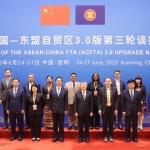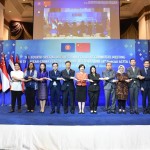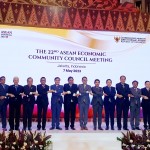Tổng số bài đăng 463.
(In the context of current geopolitical developments in the Asia-Pacific region, ASEAN announces a 5-year strategic plan, 2026-2030, with the goal of promoting financial integration, trade standards, digital infrastructure, and responding to global fluctuations to quickly become the world's fourth largest economy).
Within the framework of the 46th ASEAN Summit held in Kuala Lumpur, Malaysia, on May 26 and 27, 2025, ASEAN Leaders signed the Kuala Lumpur Declaration on ASEAN 2045: A Common Future, thereby officially announcing the 5-year strategic plan (2025–2030), including 41 pages of content with the main goals of promoting:
1. Harmonization of trade standards and supply chains;
2. Regional financial integration;
3. Liberalization of the movement of people and businesses;
4. Sustainable development and increased investment opportunities.
Then, on June 12, 2025, ASEAN countries also held the Ceremony to announce the ASEAN Economic Community Strategic Plan 2026-2030, vision 2045 to promote the economic, trade and investment goals of the region.
ASEAN's announcement of the above important documents in the context of the US-China trade war, pressure from the US threatening to impose reciprocal tariffs and regional political fluctuations shows ASEAN's determination to promote intra-bloc economic cooperation, promote sustainable economic development efforts focusing on and linking with new trends such as green economy and digital economy.
According to some studies and assessments, ASEAN is ranked fourth in the world in terms of GDP (~3.8 trillion USD) but the potential is still great if it expands integration, proactively follows current economic development trends such as digital economy, green economy, strengthens support for the micro, small and medium-sized enterprise (MSME) community and standardizes technical standards and regulations throughout the bloc. This is considered a practical and effective direction.
In that context, China and the GCC Council are also expanding relations with ASEAN - for example, China's ASEAN visa policy - creating favorable opportunities for enhancing trade and investment relations between the three parties.
However, to ensure the success of the set goals, ASEAN also needs to consider and handle a number of difficulties and challenges such as the difference in development levels among member countries, one of the factors that makes it difficult for ASEAN to reach consensus quickly, the consequences of trade protectionism and fluctuations in the supply chain. This is considered a major obstacle to ASEAN's efforts.
Throughout its regional integration process, ASEAN has been loyal to the policy of taking ASEAN as the center, promoting ASEAN's role in cooperation with external partner countries. The newly announced 5-year strategic plan and the ASEAN Economic Community Strategic Plan 2026-2030 also emphasize this factor, thereby elevating and promoting the role of the Economic Pillar in the overall ASEAN Community.
In integration and cooperation with partner countries, upgrading and promoting negotiations on ASEAN + FTAs, promoting the effective implementation of the Regional Comprehensive Economic Partnership (RCEP) will also be a tool to support ASEAN in realizing its development goals. In addition, promoting and facilitating MSMEs to operate, develop and contribute more to regional value chains through technical assistance - financial consulting - training efforts is also a necessary direction to create momentum.
Sources:
- Reuters: "ASEAN unveils strategic plan to integrate its economies"
- Times of India: "Unity now more important than ever"
- Financial Times: On China - ASEAN and GCC cooperation












